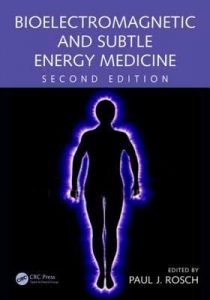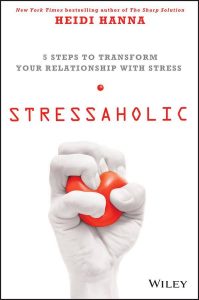Book Reviews
Bioelectromagnetic and Subtle Energy Medicine 2nd Edition
Paul J. Rosch, MD, FACP (Editor) CRC Press (Taylor & Frances Group) 2015; Boca Raton
Bioelectromagnetic and Subtle Energy Medicine focuses on a wide variety of evidence-based bioelectromagnetic and subtle energy therapies for disorders ranging from cancer, cardiomyopathy, and Parkinson’s disease to depression, anxiety, and pain. Since publication of the first edition more than a decade ago, there have been so many advances in these and other diseases, that a thorough revision is required for this resource to remain the gold standard in a burgeoning field. This second edition updates previous topics and features many new chapters describing novel approaches that promise to replace drugs or surgery because they are more effective and much safer, such as rTMS for depression, MRI-Guided Focused Ultrasound for bone and uterine tumors, and TheraBionic LEET for liver cancer. Others discuss biological water (H3O2) that acts like a battery, health benefits of Earthing, malignant and other brain tumors from cell and cordless phones, visualizing and measuring energy fields in humans and nature, making sense of homeopathy and “memory of water,” basic science support for acupuncture, electrosensitivity, ion cyclotron resonance, the role of the pineal gland, the health effects of solar storms and terrestrial influences, and why Bioelectric Resonance Therapy bridges Chinese and Western medicine. This is only a sampling of the 50 chapters contributed by authorities from the United States, Europe, Scandinavia, Russia, China, Japan, and Iran.
Review by Stephen Barchet, MD, FACOG, FACPE; FAIS, CPE Rear Admiral, Medical Corps, United States Navy, Retired Coordinator – Health Plan for Life (HP4Life) Former Deputy Surgeon General/Deputy Director Department of the U.S. Navy
Energy is the essential vital force of life without which there is no existence of organic origin, form, and function. The first edition of “Bioelectromagnetic Medicine” edited by Paul J. Rosch and Marco S. Markov was published to wide acclaim in 2004. This second edition containing 50 chapters first alerts and then informs readers there are dizzying sets of rapid changes in the very science of life itself that prompted more than the oft published chapter updates common to succeeding book editions. Demanding readers should find few disappointments in this successor to the first edition. Demanding readers should find new concepts, new pathways, and newer and different models worthy of the book’s title “Bioelectromagnetic and Subtle Energy Medicine”. As sole editor of this second expanded edition, Paul Rosch has executed a singularly difficult challenge reassembling prior and adding new authors with invitations to seed this book with hosts of changes and discoveries germane both to the first edition and reflecting the advances of science that emerged since 2004. Those advances as published here proved substantial as well as they will serve to inspire even greater advances in this next decade to follow.
This second edition represents 50 original chapters written by 95 authors and totaling in this single volume textbook over 600 pages. The content in each chapter can be read as a separate and unique exposition yet each chapter maintains an observable and tangible link with every other chapter forged by the topic of energy in its diverse guises and its effects within, surrounding, and across organic living systems.
The task of the editor of scientific tomes is a chore that if successful must fall to a person of stellar reputation and vast experience in the topics selected. Dr. Paul Rosch not only succeeded in fulfilling the task of assembling a community of profoundly able scientists but he clarifies early in his first and second edition prefaces the rationales for the divisions and the contents therein published. This book is best read by reading initially the First and Second Edition Prefaces, followed by the subsequent chapters reprinted unchanged from the First Edition. Thereafter read Chapter 48 by Dennis Stillings – “Creating the Bakken; A Library and Museum of Electricity in Life – A Mystical Memoir”. The very next choice I recommend is Chapter 50 by Editor Rosch: “Afterword: A Peek into the Future”. Choosing this sequence prepares readers to explore freely the content in the remaining chapters – a feast of science shared by scientists from around the world.
Fat and Cholesterol Don’t Cause Heart Attacks And Statins Are Not The Solution.
Paul J. Rosch, MD, FACP (Editor) Columbus Publishing Ltd, 2016; York, U.K. (Explains why stress is a far more important contributor to coronary heart disease than cholesterol LDL or saturated fat.)
 Michael Czajka Jnr Review This book is a useful compilation of information on heart disease, cholesterol, fats and health in general from multiple authors. There is a bit of overlap between authors… but it’s useful to get the same info from different perspectives. This book is a useful compilation of information on heart disease, cholesterol, fats and health in general from multiple authors. There is a bit of overlap between authors… but it’s useful to get the same info from different perspectives. This book has leading edge info on sulfation of cholesterol which is hard to obtain. I’ve been wondering for years about sulfation… now finally it’s starting to come together. The book is a good summary of why cholesterol is unlikely to be the problem… including Duane Graveline’s (NASA spacedoc) own experience. Duane has manually done counts of statin side effects using the FDA database because he wasn’t allowed access to more advanced tools. His hard work has put better numbers to the statin problem and he has clarified many of the relevant pathways. This was one of his last collaborations before his recent death from the cumulative side effects of statins.
Michael Czajka Jnr Review This book is a useful compilation of information on heart disease, cholesterol, fats and health in general from multiple authors. There is a bit of overlap between authors… but it’s useful to get the same info from different perspectives. This book is a useful compilation of information on heart disease, cholesterol, fats and health in general from multiple authors. There is a bit of overlap between authors… but it’s useful to get the same info from different perspectives. This book has leading edge info on sulfation of cholesterol which is hard to obtain. I’ve been wondering for years about sulfation… now finally it’s starting to come together. The book is a good summary of why cholesterol is unlikely to be the problem… including Duane Graveline’s (NASA spacedoc) own experience. Duane has manually done counts of statin side effects using the FDA database because he wasn’t allowed access to more advanced tools. His hard work has put better numbers to the statin problem and he has clarified many of the relevant pathways. This was one of his last collaborations before his recent death from the cumulative side effects of statins.
Book Review by Dr. Malcolm Kendrick
This book points out not only that feeding rabbits saturated fat is not a reasonable model for what occurs in humans but that many of the early trials used hydrogenated vegetable oils (turned polyunsaturated vegetable oils into saturated fats) to prove that saturated fats are bad for us. We know that trans fats (produced in hydrogenation of vegetable oils) cause heart disease… so why this crucial distinction has eluded so many researchers is perplexing. Originally the link between trans fats and heart disease was disputed which may explain some of the early confusion. This book joins the dots in this area nicely… and is the first to do so this clearly.
Fat and Cholesterol Don’t Cause Heart Attacks
There is a group of doctors, scientists and researchers called the International Network of Cholesterol Skeptics (THINCS) www.thincs.org. I am a member, and recently a number of us have contributed chapters to a new book called Fat and Cholesterol Don’t Cause Heart Attacks And Statins are Not the Solution. This was written in honor of the founder of THINCS, Uffe Ravnskov, a Swedish doctor and researcher who has been arguing against the current die-heart/cholesterol hypothesis for many years. He has written several books, many, many, research papers, and had the dubious honor of having one of his books burned, live, on television. [Finland 1992, the book was The Cholesterol Myths]. He has also been ruthlessly attacked, both professionally and personally. Yet he has never given up. Ravnskov, like all of us in THINCS, started looking at heart disease, or cardiovascular disease (CVD) and recognized that the widely accepted views were simply wrong. Something recognized by many people
over the years, including Professor George Mann (who helped to start up and run the Framingham study). ‘Saturated fat and cholesterol in the diet are not the cause of coronary heart disease. That myth is the greatest scientific deception of this century, perhaps of any century.’ George Mann, like many others, was silenced. Kilmer McCully, who discovered the role of homocysteine
in CVD, and suggested that it could be more important than cholesterol was also attacked. Funding for his research disappeared, leading to the loss of his laboratory. His hospital director told him to leave and ‘never come back’. His Harvard affiliation and tenure were terminated. Another contributor to this book, Professor Michel De Logeril, set up and ran the seminal Lyon Heart
Health Study. Possibly the seminal work on the ‘Mediterranean Diet.’ Yet he is a trenchant critic of the diet-heart hypothesis and believes that statins do more harm than good. He is, again, attacked ruthlessly. Yes, there is a pattern here. Dare to criticize the current dogma that saturated fat in the diet raises cholesterol, which then goes on to cause CVD, and your chances of progression in the research world are, precisely, zero. Your chances of getting anything published are, pretty close to zero. You will be attacked both personally and professionally. You will be accused of killing thousands of people by putting them off taking statins – and suchlike. However, those in THINGS have never given up in their efforts to get the ‘truth out there’ and never will.
This book is a further way to help inform the public about the true facts. There are chapters on competing hypotheses as to the cause(s) of CVD, there are chapters outlining the flaws in the current ideas. Some chapters are technical, others not. Everything is held together by Paul Rosch, a brilliant researcher, writer and editor, clinical professor of Medicine and Psychiatry and New York Medical College, Chairman of the Board of the American Institute of Stress, and a great, deep thinker, on many subjects. Would that there were more like him.
You can get a copy direct from the Publishers here…
About the Author
Paul J. Rosch, MA, MD, FACP is a Clinical Professor of Medicine and Psychiatry at New York Medical College, Chairman of the Board of The American Institute of Stress and Honorary Vice President of the International Stress Management Association. He did his internship and residency at Johns Hopkins and has a Workers Compensation subspecialty rating in cardiology, endocrinology, and metabolism. In 1993, he began devoting a series of sessions on the fallacies of the lipid and diet-heart hypotheses at the annual Montreux International Congress on Stress that featured leading authorities from all over the world. This was long before the advent of THINCS.. Dr. Rosch is a Fellow and Life Member of The American College of Physicians and has served as President of the New York State Society of Internal Medicine, President of the Pavlovian Society and Expert Consultant on Stress to the United States Centers for Disease Control. He has been the recipient of numerous honors here and abroad, including the Outstanding Physician’s Award of the New York State Medical Society, the Innovation Award of The International Society for the Study of Subtle Energies and Energy Medicine, The I.M. Sechenov Memorial Medal from The Russian Academy of Medical Sciences and an Award from Dr. Michael E. De Bakey, President of the American Society for Contemporary Medicine and Surgery for “Contributions to our Understanding of Stress, Health, and Disease”.
 War Trauma and Its Wake
War Trauma and Its Wake
Edited by Raymond Monsour Scurfield and Katherine Theresa Platoni
Decades after Charles Figley’s landmark Trauma and Its Wake was published, our understanding of trauma has grown and deepened, but we still face considerable challenges when treating trauma survivors. This is especially the case for professionals who work with veterans and active-duty military personnel. War Trauma and Its Wake, then, is a vital book. The editors—one a contributor to Trauma and Its Wake, the other an army reserve psychologist with four deployments who chairs our Combat Stress Board—have produced a book that addresses both the specific needs of particular warrior communities as well as wider issues such as battlemind, guilt, suicide, and much, much more. Published by Routledge, Taylor and Francis.
DESCRIPTIONS:
Figley, Foreword.
Scurfield, Platoni, An Expanding Circle of Healing: Warriors and Civilians Impacted by War. Scurfield, Platoni, Myths and Realities about War, Its Impact, and Healing.
Part I: Warriors Impacted by War.
Rabb, Rasmussen, Citizens/Warriors: Challenges Facing U.S. Army Reserve Soldiers and Their Families. Courage, Army National Guard Warriors: A Part-Time Job Becomes a Full-Time Life. Wilmot, Women Warriors: From Making Milestones in the Military to Community Reintegration. Brock, Passey, The Canadian Military and Veteran Experience.
Part II: Special Populations of Wounded Warriors.
Rigg. Traumatic Brain Injury and Post Traumatic Stress: The “Signature Wounds” of the Iraq and Afghanistan Wars. Lawrence, Physically Wounded and Injured Warriors and Their Families: The Long Journey Home. Jensen, Military Suicidality and Principles to Consider in Prevention. Rasmussen, Zaglifa, Military Sexual Trauma. Simerly, Veterans Involved With the Criminal Justice System: Clinical Issues, Strategies, and Interventions.
Part III: Civilian Populations Impacted by War.
Dawoody, Iraqi Civilians and the Recycling of Trauma. Badkhen, Afghan Civilians: Surviving Trauma in a Failed State.
Part IV: Military and Resiliency Initiatives.
Hallman, Pischke, U.S. Army Combat and Operational Stress Control: From Battlemind to Resiliency, Debriefings, and Traumatic Event Management. Reyes, Enhancing Resiliency Through Creative Outdoor/Adventure and Community-Based Programs. Morley, Anderson, O’Hara, ArtReach: Project America and Other Innovative Models in Civilian-Military Partnering. Purinton, Military Chaplains’ Roles in Healing: “Being Hereand There.”
Afterword: A Surviving Spouse Speaks.
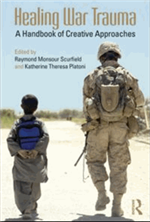 Healing War Trauma: A Handbook of Creative Approaches
Healing War Trauma: A Handbook of Creative Approaches
Edited by Raymond Monsour Scurfield & Katherine Theresa Platoni
Healing War Trauma details a broad range of exciting approaches for healing from the trauma of war. The techniques described in each chapter are designed to complement and supplement cognitive-behavioral treatment protocols—and, ultimately, to help clinicians transcend the limits of those protocols. For those veterans who do not respond productively to—or who have simply little interest in—office-based, regimented, and symptom-focused treatments, the innovative approaches laid out in Healing War Trauma will inspire and inform both clinicians and veterans as they chart new paths to healing. Chapter 12 is on Cranial Electrotherapy Stimulation (CES) with Alpha-Stim: Mild Electrical Triage of the Brain with War Veterans by Dr. Daniel L. Kirsch.
SELECTED CONTENTS:
Part I: Surviving Both War and the Battles Back Home.
Rabb, Introduction. Scurfield, Platoni, Rabb. Survival Modes, Coping, and Bringing the War Home: From Vietnam to Iraq and Afghanistan. Zacchea, Veterans’ Advocacy: Social Justice and Healing Through Activism.
Part II: Culture-Specific and Community- Based Approaches.
Wilson, Culture-Specific Pathways to Healing and Transformation for War Veterans Suffering PTSD. Valdes, The Journey Home From War: The Quilt and Pillow Pal Ceremony. Csandl, Veterans’ Sanctuary: The Journey to Open a Therapeutic Community.
Part III: Expressive-Experiential Approaches.
Wise, Nash, Metaphor as Heroic Mediator: Imagination, Creative Arts Therapy, and Group Process as Agents of Healing With Veterans. Capps, Writing by Service Members and Veterans: A Medium to Promote Healing in Self and Others. Daniels, War-Related Traumatic Nightmares as a Call to Action.
Part IV: Mind-Body Approaches. Mizuki, Mindful-Awareness Practice to Foster Physical, Emotional and Mental Healing with Service Members and Veterans.
Platoni, Hypnotherapy in the Wartime Theater and Afterwards: OIF, OEF and Beyond. Kirsch, Cranial Electrotherapy Stimulation (CES) with Alpha-Stim Mild Electrical Triage of the Brain with War Veterans.
Part V: Animal-assisted/Outdoor Approaches. Cortani, Service Dogs and Other Canine Assistance Services for Wounded Warriors.
Buckley, Raulerson, Back in the Saddle and SCUBA Warriors: Innovative Therapies to Healing.
Part VI: Technological/ Web-based Approaches. Casura, Healing Combat Trauma: The Website, the Vision, the Impact.
Rizzo, SIMCOACH: An Online Intelligent Virtual Human Agent System for Breaking Down Barriers to Care for Service Members and Veterans.
Part VII: Other Creative Approaches. Scurfield, Platoni, Resolving Combat-related Guilt and Responsibility Issues.
Williams, Slogging the Bog of War to Return to the World of Work. Lanham, Pelletier, Spirituality in Facilitating Healing From War Trauma. Scurfield, Platoni, Afterword.
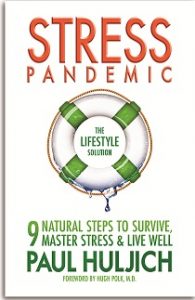 Stress Pandemic: The Lifestyle Solution
Stress Pandemic: The Lifestyle Solution
Written by AIS Member Paul Huljich
Paul Huljich, AIS Member and co-founder of Best Corporation, (a pioneering organic foods company in New Zealand) has shared his personal story of leading his company to great success, while driving himself to a complete nervous breakdown. This book is a hybrid: Cautionary Tale/Guidebook for ordinary people who are living with chronic stress in their lives. Mr. Huljich’s shares a vivid description of how unmanaged stress overtook his health and left him in a swift downward spiral, ultimately resulting in being institutionalized and diagnosed with bipolar disorder. His story resonates with openness and honesty that can only come from someone who has “been there”. Mr. Huljich rejected the grim recommendation to take psychotropic drugs for the rest of his life and began to research and explore natural ways to heal himself. In this book, Mr. Huljich offers “9 Natural Steps” to become aware of the stressors in your life as well as empowering techniques to minimize their harmful health effects. The preventative and restorative measures Mr. Huljich implemented to restore his health are well researched and scientifically proven to relieve stress and improve health. Mr. Huljich represents AIS Membership well with this book. Through his life experiences we can all learn the valuable lesson to manage the stress in our lives, before we manage to ruin our health.
– Kellie Marksberry, former Executive Director, The American Institute of Stress
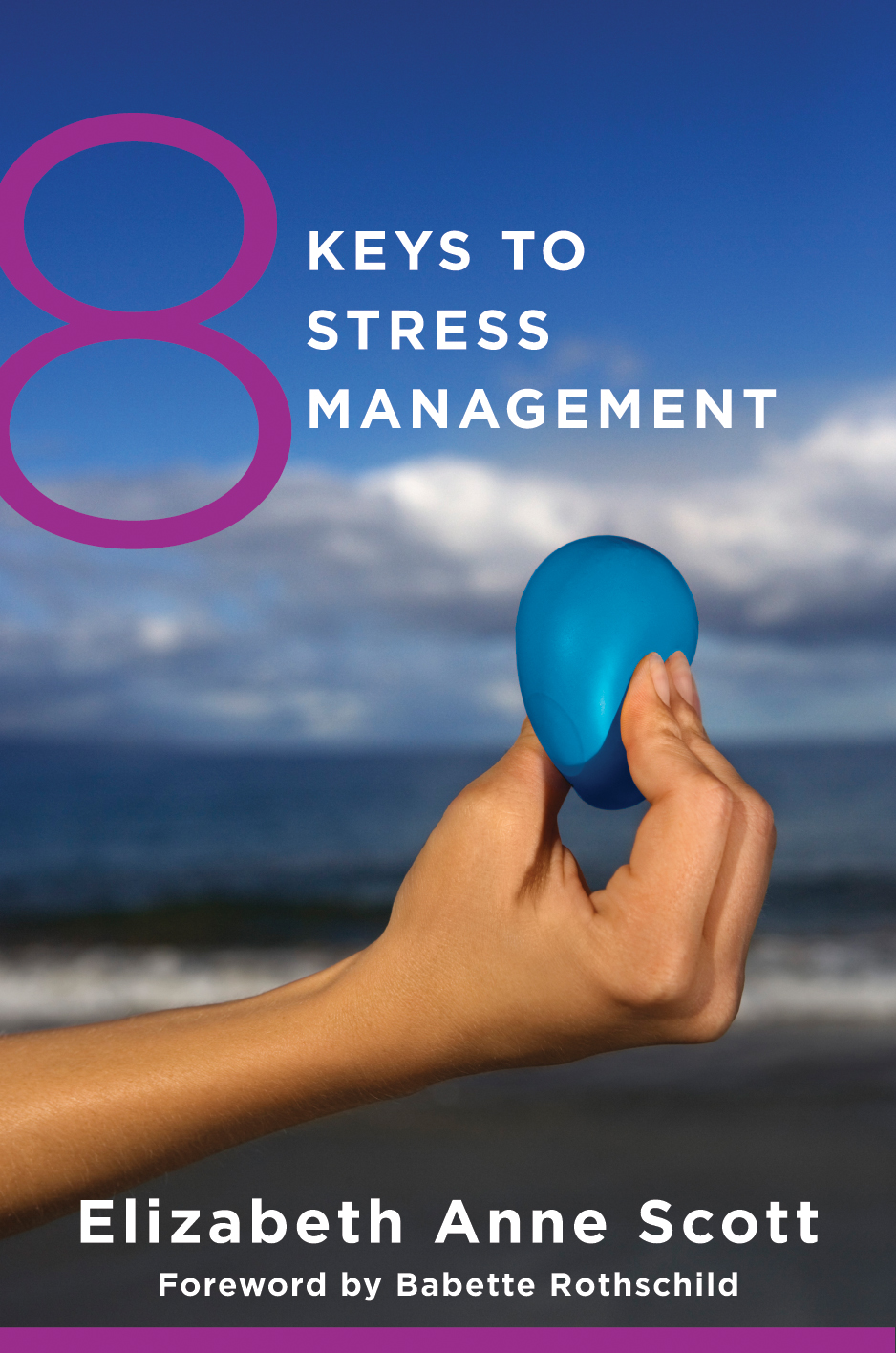 8 Keys to Stress Management
8 Keys to Stress Management
Written by AIS Diplomate Elizabeth Scott
8 Keys to Stress Management written by Elizabeth Scott, MS, DAIS, is one empowering part of a series called “8 Keys to Mental Health.” It was written in Ms. Scott’s usual clear and accessible style and leads readers through the processes and challenges of making changes in their lives in order to manage and reduce the negative impact of stress. With each of her 8 Keys, Ms. Scott uses real world examples and evidence- based strategies to teach effective stress management techniques. The 8 Keys help readers recognize stressors and become aware of their power to reduce and reverse the impact of stress. Each chapter contains suggested activities, self administered questionnaires and helpful hints that prompt and encourage self- evaluation, shifts in perspective and personal growth. This book is a valuable resource that allows any reader to create a custom stress management plan so that they can enjoy the benefits of resolved or reduced stress. The book is designed to be effective for people who are busy and overwhelmed. It can be read cover to cover or in bits and pieces, skipping to Keys that seem more relevant at the time of reading. Ms. Scott has created a comprehensive resource that lends itself to easy reading and re-reading, through the inevitable stress induced peaks and valleys of happiness and contentment experienced in daily life.
– Kellie Marksberry, former Executive Director, American Institute of Stress
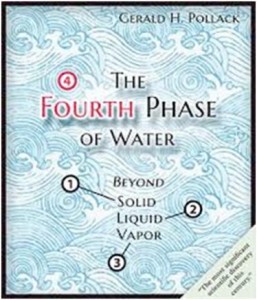 The Fourth Phase of Water: Beyond Solid, Liquid, and Vapor
The Fourth Phase of Water: Beyond Solid, Liquid, and Vapor
Written by Gerald H. Pollack.
Ebner & Sons, Publishers. Seattle, 2013
Water, thou hast no taste, no color, no odor; canst not be defined, art relished while ever mysterious. Not necessary to life, but rather life itself, thou fillest us with a gratification that exceeds the delight of the senses. ~Antoine de Saint-Exupery Wind, Sand and Stars, 1939
As noted in numerous quotes in Health and Stress magazine, water is wonderful, but it is also mysterious, if not weird. Did you ever wonder why you sink in dry sand but can walk on the wet sand of a beach or use it to build sand castles and sculptures because of its adhesive properties? Why does water form droplets on some surfaces but not others? How are some lizards able to walk on water when their weight should make them sink? Gelatin desserts are 90% or more water, so why doesn’t it leak out? Why do raindrops fall faster than they should and provide more energy to plants and crops than bulk water? Why is ice usually slippery but sometimes sticky? Why does warm water freeze faster than cold water? Most things contract and become denser when they freeze, but when water freezes, it expands. That’s why pipes burst and ice forms on the top of ponds and lakes where it floats on water. How does water get from the roots to the top of a plant or a tall tree?
These are some of the numerous questions answered in this fascinating book about the discovery of a new phase of water that is denser and more alkaline than H2O. Its formula is believed to be H3O2, so it has a negative charge, and like a battery, can hold energy and make it available when needed. Professor Pollack has named this EZ (exclusion zone) water, since his meticulous research shows it has a clearly demarcated zone that excludes even small molecules. Others have referred to it as “structured”, “biological” or “living” water. EZ water is a crystalline stage that is necessary for water to be converted to ice and vice versa. It occurs in nature when snow, glaciers and icebergs are formed, which is why glacial melt is very rich in EZ water. It has been estimated that 99% of the molecules in the body are water, but most EZ water is intracellular, which may be why the body’s cells have a negative charge. The energy in this water comes from light, especially in the infrared range, which may be why infrared saunas and exposure to the sun makes us feel better. Since EZ water has more oxygen, it might also mimic the healing effects of hyperbaric oxygen therapy.
As the author notes, much of this might have been discovered sooner were it not for the fact that during the Cold War in the 1960’s, Russian scientists described a new kind of water with remarkable properties. It was difficult to freeze or vaporize, was unusually dense and behaved differently in capillary tubes. Scientists all over the world were intrigued because of the stellar reputation of the researchers, which included Russia’s leading physical chemist. It was dubbed “polywater” because it seemed to act like a polymer, and there were fears that if it behaved like other polymers used to make plastics, a few drops of polywater in the ocean could polymerize and ruin the earth’s water supply. It was not until the 1970’s that it was finally discovered that all these anomalous activities were entirely due to impurities that had not been detected. But the damage had been done and research on water came to an abrupt halt, save for scientists like Jacques Benveniste. Two decades later, he proposed the existence of “memory” in water, and as previously noted, was so persecuted, that others who confirmed his results were afraid to publish them.
One of the most appealing aspects of EZ water is that it could explain how blood is able to circulate through the capillary system and defy gravity by traveling from the roots of a tree to nourish its branches and leaves at the top. While much of this seems like it would be tedious reading, the author has done a remarkable job in making complex issues readily comprehensible and explaining technical jargon in simple terms. All of this is significantly enhanced by copious illustrations and diagrams by Ethan Pollack, a very talented artist who happens to be the author’s son. Sounds like this must have been fun to write and there can be little doubt that it is fun as well as fascinating to read.
– Paul J. Rosch, MD, Chairman of the Board,The American Institute of Stress
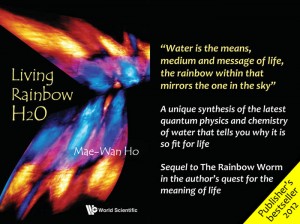 The Living Rainbow- H2O
The Living Rainbow- H2O
Written by Mae-Wan Ho
World Publishing Co. Ltd. Singapore, 2012
It is difficult to say anything about Living Rainbow H2O without explaining that it is a sequel to The Rainbow and the Worm, The Physics of Organisms, first published in 1992. It attempted to answer questions posed four decades earlier by the Nobel Laureate, Erwin Schrödinger in What is Life? The Physical Aspect of the Living Cell. Often called the father of quantum physics, Schrödinger’s most important question was “How can the events in space and time which take place within the spatial boundary of a living organism be accounted for by physics and chemistry?”
In Ho’s opinion, the problem did not lie in physics, chemistry or biology, but rather that we study the relationship of these disciplines to being alive from a mechanistic and reductionist Newtonian viewpoint. Her subtitle, The Physics of Organisms, did not refer to conventional biophysics, which insists on applying traditional thermodynamic laws to living systems. As she notes, life is not a material thing or structure, but a process that exists on a “spectrum based on organized and quantum-coherent energy”. This can only be understood by minimally invasive observations that do not destroy tissue or disrupt function. However, we study living things by killing them and analyzing various components in a futile attempt to understand how they work in such a highly organized, coordinated and productive manner. She expanded on this in subsequent revisions by explaining that quantum coherence is a state of being whole that involves molecules acting in perfectly correlated ways. The result is a “pattern of dynamic flow of matter and energy that somehow makes the organisms alive, enabling them to grow, develop and evolve.” Her last and much enlarged 2008 revision included new findings on the crucial role of biological water in synchronizing living processes.
Living Rainbow H2O picks up where this left off by reviewing subsequent advances in quantum physics and chemistry that explain why liquid crystalline water in the living matrix is “the means, medium and message of life.” Such structured water provides the electricity that animates us and facilitates the rapid and efficient intercommunication that characterizes quantum coherent systems. Ho uses the analogy of “quantum jazz” to illustrate this, since while individual performers do their own thing, much like a cadenza in a concerto, it is still congruent with the ensemble, and the final whole is greater than the sum of its parts. As she explains, “There is no conductor or choreographer. Quantum jazz is written as it is performed; each gesture, each phrase is new, shaped by what has gone before, though not quite.” Similarly, “Quantum jazz is the music of the organism dancing life into being. It is played out by the whole organism, in every nerve and sinew, every muscle, every single cell, molecule, atom and elementary particle, a light and a sound show that spans 70 octaves in all the colors of the rainbow.”
Although each of the 23 chapters is a paean of praise to the remarkable properties and powers of water, they also explain the “thermal threshold” fallacy, ion cyclotron resonance, memory of water, and why homeopathy and acupuncture provide benefits. The author is careful to explain these and other complex topics and terms so that they are readily comprehensible to a lay reader. At the same time, her compelling narrative does not miss a beat as she simultaneously documents scientific details for those who want additional information or proof.
Instead of chasing rainbows, Ho has caught hers. It is “the rainbow within”, because its liquid crystalline state enables water molecules to line up and move coherently together, which creates the colors of the rainbow when viewed with a polarizing microscope. It is impossible to do justice to this book in a few paragraphs, other than to say that anyone who reads it will find new and fascinating answers to questions that have puzzled scientists for decades.[/toggle]
– Paul J. Rosch, MD, Chairman of the Board, The American Institute of Stress
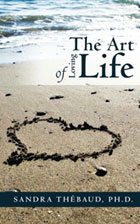 The Art of Loving Life
The Art of Loving Life
Written by AIS Fellow Sandra Thebaud, PhD
Dr. Sandra Thebaud, a Fellow of AIS, has written a book for the masses. Dr. Thebaud shares her personal story of living through a stressful divorce and how becoming aware of and managing her stress effectively, enabled her to “get through the fog” and on to loving life! Everyone will be able to relate to her words in some way as she helps you to identify what is holding you back from living your best life. Her book follows the outline of one of her highly attended stress management workshops—introducing very common, but highly effective stress management techniques. She takes you step by step through defining your personal stressors, understanding the ways in which stress affects your health and asks you to examine your own life and ind ntify areas in which you can start to make changes. If you would like to reduce the stress in your life and enjoy happier and healthier days this is a good starting point.
– Kellie Marksberry, former Executive Director, The American Institute of Stress
 What Went Wrong: The Truth behind the Clinical Trial of the Enzyme Treatment of Cancer
What Went Wrong: The Truth behind the Clinical Trial of the Enzyme Treatment of Cancer
Written by AIS Fellow Nicholas J. Gonzalez, M.D.
This book is about a $1.4 million grant award by the National Cancer Institute in 1998 to do a controlled clinical trail comparing the chemotherapeutuc drug Gemzar to Dr. Gonzalez’ enzyme approach in the treatment of patients with pancreatic cancer. Dr. Gonzalez documents how the study was mismanaged, how he had no control over the selection of patients, and how the protocol was violated in numerous ways that were subsequently confirmed by regulatory authorities. Nevertheless, a misleading article was published without his knowledge and none of the responsible parties were ever admonished or held accountable. This tragic tale tends to support a growing suspicion that the cancer cartel of organizations, government agencies and vested interests is devoted more to preserving their enormous profits and reputations than to the prevention and cure of cancer.”
– Paul J. Rosch, M.D., Chairman of the Board, The American Institute of Stress
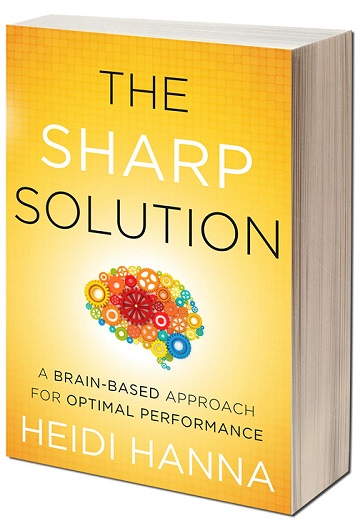 The SHARP Solution
The SHARP Solution
Written by AIS Fellow Heidi Hanna, PhD
“The SHARP Solution” is a well written, science-based approach to incorporating sustainable behavior change to reduce stress and increase over-all wellbeing. Dr. Hanna guides you through designing a personal action plan to decrease your daily stress and live a longer healthier life. The book provides an inside-out perspective of how the body functions on a physiological and psychological level when under stress. The focus is on building resilience through mindfulness, meditation, balanced nutrition and dedicated relaxation time. The book is organized into five phases: brain, heart, mind, body and community. The focus is not on “WHAT” you should be doing to relieve your stress and be healthier, but “HOW” to take the knowledge that most of us have heard repeated throughout our lives, and actually make small sustainable changes to maintain a healthy lifestyle. Dr. Hanna emphasizes nutrition, physical activity, rest and most importantly cognitive fitness. The book guides you through various aspects of brain training through her “SHARP Brain Recharge” technique. The process is simple by design. It offers a variety of short, effective methods to help you shift out of a stress response into the relaxation response in just a few moments. Dr. Hanna provides a toolbox of simple techniques that you can practice and incorporate into your busy life without adding more stress and strain as you struggle to find time to relax. Through this book Dr. Hanna represents the essence of our mission at The American Institute of Stress – to provide evidence based information and simple to follow techniques to reduce stress and improve your quality of life.
– Dr. Daniel L. Kirsch, President , The American Institute of Stress
Stressaholic
Written by Dr. Heidi Hanna, AIS Fellow
A guidebook for the journey from exhaustion to enlightenment
Chronic multitasking and ever-increasing demands on our time and energy have caused a neurochemically-based dependence on sources of stress and stimulation to provide fuel for our chaotic lifestyles. While this may boost performance in the short-term, studies have consistently shown that when stress hormones are elevated over time they create the worst form of internal wear and tear; decreasing productivity, wasting time, and even killing brain cells. As a result, modern society is tired and wired, suffering from physical exhaustion while mentally amped up, and unable to get adequate rest.
Stress in and of itself is not bad, and is actually utilized for growth when balanced with adequate recovery. The solution to stress addiction is to build in and prioritize optimal rest and relaxation on a holistic level—body, mind, and spirit—in order to consistently recharge and create a more resilient operating system.
Stressaholic shows you how to win the war on stress without limiting progress by creating an optimal performance pulse of stress and recovery for life.
- Explains the impact of chronic stress on the human operating system; body, mind, and spirit
- Shows how a simple shift in mindset can dramatically alter physiological responses to stress
- Reveals simple techniques for altering daily stress patterns to improve natural rhythms, creating a personalized performance pulse
With easy to implement tips and real-world examples of people and organizations that have turned stress into sustainable drive, Stressaholic will guide you on your journey from exhaustion to enlightenment!

